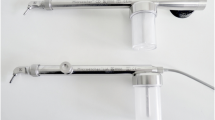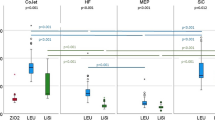Abstract
In oral orthodontic treatments, achievement of a good adhesion between brackets and teeth surfaces is essential. One way to increase adhesion is to apply a surface treatment of teeth facing surfaces through the projection of abrasive particles to produce a surface roughness which improves adhesion of the bracket to the tooth, because of the significantly increased contact between the two surfaces. The effect on adhesion through the use of this technique in different types of brackets, as well as through the use of different blasting particles, however, is yet not well described. In this study we have included three types of brackets which are commonly used in orthodontic therapies (two of them a mesh-type and the third one a micro-milled type) with a contact surface area of 11.16, 8.85 and 6.89 mm2 respectively. These brackets were used combined with a sandblasting treatment with two different types of abrasive particles, alumina (Al2O3) and silicon carbide (SiC) and applied to natural teeth in vitro. The abrasive particles used are bio-compatible and usually used in achieving increased roughness for improved adherence in biomedical materials. Sandblasting was performed at 2 bars for 2 s; three particle sizes were used: 80, 200 and 600 μm. Non-blasted samples were used as control. Each of the pieces were cemented to natural teeth with a self-curing composite. Samples were stored in physiologic serum at 5°C temperature. Tensile tests were performed with a universal testing machine. Brackets treated with sandblasted particles were measured to have an increased adhesion as compared to the control sample. The highest bond strength was measured for samples sandblasted with alumina particles of 80 and 200 μm combined with micro-milled brackets. The recorded stresses did not exceed the tensile strength of tooth enamel.




Similar content being viewed by others
References
Schmage P, Nergiz I, Herrmann W, Ozcan M. Influence of various surface-conditioning methods on the bond strength of metal brackets to ceramic surfaces. Am J Orthod Dentofacial Orthop. 2003;123(5):540–6.
Cochran D, O’keefe KL, Turner DT, Powers JM. Bond strength of orthodontic composite cement to treated porcelain. Am J Orthod Dentofacial Orthop. 1997;111(3):297–300.
Silverstone LM. In: Dogon L, editor. The acid etch technique: in vitro study with special reference to the enamel surface and the enamel-resin interface. Minnesota: St. Paul; 1975.
Sargison AE, Mccabe JF, Millett DT. A laboratory investigation to compare enamel preparation by sandblasting or acid etching prior to bracket bonding. Br J Orthod. 1999;26(2):141–6.
Siomka LV, Powers JM. In vitro bond strength of treated direct-bonding metal bases. Am J Orthod. 1995;88:133–6.
Sonis AL. Air abrasion of failed bonded metal brackets: a study of shear bond strength and surface characteristics as determined by scanning electron microscopy. Am J Orthod Dentofacial Orthop. 1996;110:96–8.
Dasch W, Turner DS, Powers JM. Bond strength of a light-cured glass ionomer orthodontic adhesive. J Dent Res. 1993;72:224–5.
Wright WL, Powers JM. In vitro tensile bond strength of reconditioned brackets. Am J Orthod. 1985;87:247–52.
Egan FR, Alexander SA, Cartwright GE. Bond strength of rebonded brackets. Am J Orthod Dentofacial Orthop. 1996;109:64–70.
Black RB. Air-abrasive: some fundamentals. J Am Dent Assoc. 1950;40:701–10.
Millett D, Mccabe JF, Gordon PH. The role of sandblasting on the retention of metallic brackets applied with glass ionomer cement. Br J Orthod. 1993;20(2):117–222.
Regan D, Lemasney B, Van-Noort R. The tensile bond strength of new and rebonded stainless steel orthodontic brackets. Eur J Orthod. 1993;15(2):125–35.
Miller S, Zernik JH. Sandblasting of bands to increase bond strength. J Clini Orthod. 1996;30:217–22.
Jost-Brinkmann PG, Miethke RR, Appenzeller AH. An in vitro study on improving the bonding strength of steel bands with the use of glass ionomer cements. Fortschr Kieferorthop. 1993;54:148–55.
Zachrisson YO, Zachrisson BU, Buyukyilmaz T. Surface preparation for orthodontic bonding to porcelain. Am J Orthod Dentofacial Orthop. 1996;109(4):420–30.
Cochran D, O’keefe KL, Turner DT. Bond strength f orthodontics composite cement to treated porcelain. Am J Orthod Dentofacial Orthop. 1997;111:297–300.
López Barajas L, Canut Brusola JA. In vitro comparison of the retention capacity of new aesthetics brackets. Eur J Orthod. 1999;21:71–7.
Maccoll GA, Rossouw PE, Titley KC, Yamin C. The relationship between bond strength and orthodontic bracket base surface area with conventional and microetched foil-mesh bases. Am J Orthod Dentofacial Orthop. 1998;113(3):276–81.
Shahverdi S, Canay S, Sahin E, Bilge A. Effects of different surface treatment methods on the bond strength of composite resin to porcelain. J Oral Rehabil. 1998;25:699–705.
Nergiz I, Schmage P, Herrmann W, Ozcan M. Effect of alloy type and surface conditioning on roughness and bond strength of metal brackets. Am J Orthod Dentofacial Orthop. 2004;125(1):42–50.
Cotton Wilkinsson J. In: Limusa, editor. Advanced Inorganic Chemistry. New York: Wiley; 1990.
Cochran D, O’keefe KL, Turner DT, Powers JM. Bond strength of orthodontic composite cement to treated porcelain. Am J Orthod Dentofacial Orthop. 1997;111(3):297–300.
Sharma-Sayal SK, Rossouw PE, Kulkarni GV, Titley KC. The influence of orthodontic bracket base design on shear bond strength. Am J Orthod Dentofacial Orthop. 2003;124(1):74–82.
Author information
Authors and Affiliations
Corresponding author
Rights and permissions
About this article
Cite this article
Espinar-Escalona, E., Barrera-Mora, J.M., Llamas-Carreras, J.M. et al. Improvement in adhesion of the brackets to the tooth by sandblasting treatment. J Mater Sci: Mater Med 23, 605–611 (2012). https://doi.org/10.1007/s10856-011-4509-y
Received:
Accepted:
Published:
Issue Date:
DOI: https://doi.org/10.1007/s10856-011-4509-y




